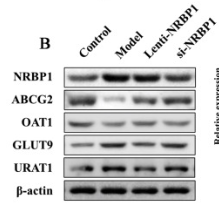NRBP1 Antibody - #DF10146
| Product: | NRBP1 Antibody |
| Catalog: | DF10146 |
| Description: | Rabbit polyclonal antibody to NRBP1 |
| Application: | WB IF/ICC |
| Cited expt.: | WB |
| Reactivity: | Human, Mouse, Rat |
| Prediction: | Pig, Zebrafish, Bovine, Horse, Sheep, Rabbit, Dog, Chicken, Xenopus |
| Mol.Wt.: | 60 kDa; 60kD(Calculated). |
| Uniprot: | Q9UHY1 |
| RRID: | AB_2840726 |
Related Downloads
Protocols
Product Info
*The optimal dilutions should be determined by the end user. For optimal experimental results, antibody reuse is not recommended.
*Tips:
WB: For western blot detection of denatured protein samples. IHC: For immunohistochemical detection of paraffin sections (IHC-p) or frozen sections (IHC-f) of tissue samples. IF/ICC: For immunofluorescence detection of cell samples. ELISA(peptide): For ELISA detection of antigenic peptide.
Cite Format: Affinity Biosciences Cat# DF10146, RRID:AB_2840726.
Fold/Unfold
BCON3; MADM; MUDPNP; Multiple domain putative nuclear protein; Myeloid leukemia factor 1 adaptor molecule; NRBP; NRBP_HUMAN; NRBP1; Nuclear receptor binding protein; Nuclear receptor-binding protein;
Immunogens
A synthesized peptide derived from human NRBP1, corresponding to a region within the internal amino acids.
- Q9UHY1 NRBP_HUMAN:
- Protein BLAST With
- NCBI/
- ExPASy/
- Uniprot
MSEGESQTVLSSGSDPKVESSSSAPGLTSVSPPVTSTTSAASPEEEEESEDESEILEESPCGRWQKRREEVNQRNVPGIDSAYLAMDTEEGVEVVWNEVQFSERKNYKLQEEKVRAVFDNLIQLEHLNIVKFHKYWADIKENKARVIFITEYMSSGSLKQFLKKTKKNHKTMNEKAWKRWCTQILSALSYLHSCDPPIIHGNLTCDTIFIQHNGLIKIGSVAPDTINNHVKTCREEQKNLHFFAPEYGEVTNVTTAVDIYSFGMCALEMAVLEIQGNGESSYVPQEAISSAIQLLEDPLQREFIQKCLQSEPARRPTARELLFHPALFEVPSLKLLAAHCIVGHQHMIPENALEEITKNMDTSAVLAEIPAGPGREPVQTLYSQSPALELDKFLEDVRNGIYPLTAFGLPRPQQPQQEEVTSPVVPPSVKTPTPEPAEVETRKVVLMQCNIESVEEGVKHHLTLLLKLEDKLNRHLSCDLMPNENIPELAAELVQLGFISEADQSRLTSLLEETLNKFNFARNSTLNSAAVTVSS
Predictions
Score>80(red) has high confidence and is suggested to be used for WB detection. *The prediction model is mainly based on the alignment of immunogen sequences, the results are for reference only, not as the basis of quality assurance.
High(score>80) Medium(80>score>50) Low(score<50) No confidence
Research Backgrounds
May play a role in subcellular trafficking between the endoplasmic reticulum and Golgi apparatus through interactions with the Rho-type GTPases. Binding to the NS3 protein of dengue virus type 2 appears to subvert this activity into the alteration of the intracellular membrane structure associated with flaviviral replication.
Cytoplasm>Cell cortex. Endomembrane system. Cell projection>Lamellipodium.
Note: Colocalizes with activated RAC3 to endomembranes and at the cell periphery in lamellipodia.
Ubiquitously expressed in all tissues examined with high levels in the testis.
The protein kinase domain is predicted to be catalytically inactive.
Belongs to the protein kinase superfamily. Ser/Thr protein kinase family.
References
Application: WB Species: Human Sample: HK-2 cells
Application: WB Species: human Sample: HK-2 cells
Restrictive clause
Affinity Biosciences tests all products strictly. Citations are provided as a resource for additional applications that have not been validated by Affinity Biosciences. Please choose the appropriate format for each application and consult Materials and Methods sections for additional details about the use of any product in these publications.
For Research Use Only.
Not for use in diagnostic or therapeutic procedures. Not for resale. Not for distribution without written consent. Affinity Biosciences will not be held responsible for patent infringement or other violations that may occur with the use of our products. Affinity Biosciences, Affinity Biosciences Logo and all other trademarks are the property of Affinity Biosciences LTD.


